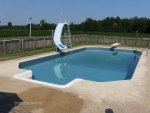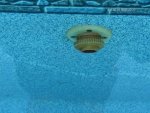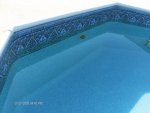My pool has a leak, it is only leaking when the pump is running. If I let it run over night it will loose about an inch of water, vise 1/8 inch without the pump running.
I replaced the valve gasket and tension spring hoping I was loosing water into the waste line, unfortunately I am still loosing water when the pump is running.
I do not have any air bubbles in the suction window at the pump.
I cannot find any wet areas around the pool at all, so it must be soaking into the ground quickly.
While doing a perimeter inspection of the liner I noticed a gurgling sound coming from what sounded like the back side of the pool wall, adjacent to one of the return jets. If I block the jet with my hand the gurgling sound changes. If I turn the pump off the liner will wrinkle just below the jet. When I turn the pump back on the wrinkle smoothes out and goes away.
I’m pretty sure I have a leaky line on the other side of this jet, but I don’t want to cut the concrete, and dig up the line until I am sure this is the best way to fix it.
Anyone have any ways to confirm this is my leak?
I replaced the valve gasket and tension spring hoping I was loosing water into the waste line, unfortunately I am still loosing water when the pump is running.
I do not have any air bubbles in the suction window at the pump.
I cannot find any wet areas around the pool at all, so it must be soaking into the ground quickly.
While doing a perimeter inspection of the liner I noticed a gurgling sound coming from what sounded like the back side of the pool wall, adjacent to one of the return jets. If I block the jet with my hand the gurgling sound changes. If I turn the pump off the liner will wrinkle just below the jet. When I turn the pump back on the wrinkle smoothes out and goes away.
I’m pretty sure I have a leaky line on the other side of this jet, but I don’t want to cut the concrete, and dig up the line until I am sure this is the best way to fix it.
Anyone have any ways to confirm this is my leak?




